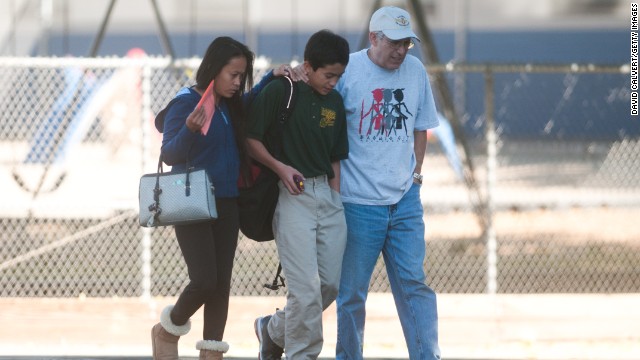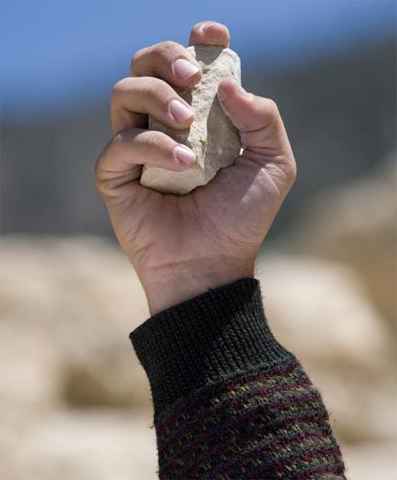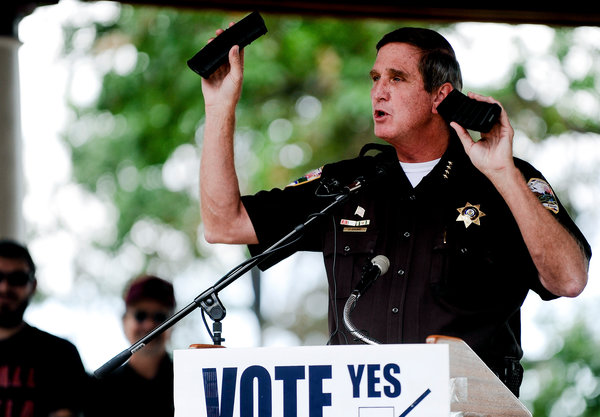Surge in luxury shooting ranges caters to new gun culture
Surge in luxury shooting ranges caters to new gun culture
‘We’re an entertainment complex, if you will,’ Lock & Load's manager says
By Jason Sickles, Yahoo | Yahoo News
Wed, Mar 12, 2014
FRISCO, Texas — It’s the lunch hour on a recent Wednesday, and pricey sedans outnumber pickups parked at the crowded parking lot of the indoor Frisco Gun Club.
Mercedes, BMW, Lexus — they're all here.
Inside the club, men sit in leather chairs and do business over a gourmet lunch.
A middle-aged woman browses a spacious shopping area and eyes a purse designed to conceal a handgun.
The club’s marketing manager talks up a future pizza-and-pistol family night promotion.
All the while, less than 100 feet away, more than a dozen shooters blast targets on ranges where a state-of-the-art ventilation system purifies the air.
Take note Elmer Fudd — this is definitely not your granddaddy's good ol’ boy retreat.
“It’s like a country club,” said Jason Tanaka, a 40-year-old mortgage executive who skipped lunch to put 100 rounds through his new semi-automatic pistol.
While the $12 million Frisco Gun Club bills itself as the “nation's premiere indoor shooting range,” it is certainly not alone. In gun-friendly locales from the Rocky Mountains to Miami and Vegas to Virginia, more than a dozen “guntry clubs” have gone into business in the past three years.
“They are popping up more often now than they did five years ago,” said Zach Snow, promotions manager with the National Shooting Sports Foundation (NSSF), which represents the industry’s manufacturers and dealers.
Frisco Gun Club, a posh 43,000-square-foot facility located in the heart of an affluent Dallas suburb, sold 2,400 memberships before opening its doors this past Thanksgiving.
“One of the differences from your typical gun range is when you walk in this building, is it feels a little more like walking into a high-end department store,” said Brandon Johnson, the club’s vice president of marketing.
It’s a stark contrast to legacy shooting ranges. Many of those are relegated to warehouse districts or are outdoors on the fringes of town.
Not so for these clubs. Lock & Load Miami is nestled among galleries and museums in the city’s Wynwood Arts District. The Centennial Gun Club is minutes from the Denver Tech Center and training facilities for the Denver Broncos and Colorado Avalanche. Strip Gun Club in Las Vegas is 59 steps from the Stratosphere Casino, Hotel & Tower.
The boom in luxury shooting ranges comes during a polarizing time in the country’s gun ownership debate. Last October, a Gallup poll found that the nation remains divided over passing stricter gun laws. But firearms sales spiked to an all-time high in 2013 as Congress and several states wrangled with imposing tighter restrictions on gun purchases in the wake of Sandy Hook and other mass shootings.
Jimmy Taylor, a sociology professor at Ohio University and author “American Gun Culture,” said the best estimates are that there are more than 200 million working firearms in circulation, with close to 40 percent of U.S. households reporting owning guns.
“It makes sense with that big of a market that it would happen,” Taylor said of the premiere ranges.
Nor is he surprised that people are craving a country club feel.
“By default societies specialize more, we differentiate more, we have a tendency to put things in some sort of rank order,” Taylor said.
Josh Sugarmann, executive director at the Violence Policy Center, disputes the 40 percent figure, saying other research shows household gun ownership being closer to 33 percent and continuing to decline.
“They are constantly trying to find new avenues to increase gun sales and to normalize gun ownership, not just to adults but to children,” said Sugarmann, adding that luxury ranges are still a risk for injury and lead contamination. “It's kind of like turning strip clubs into gentleman's clubs — it's still at its core the same concerns and the same dangers.”
Despite their opulence and VIP offerings, most of these new ranges are open to the public. Retail sales, service and memberships are how they make their money.
“What better way can you create a memorable corporate event, host a club meeting, or kick-start a bachelor party than with fully automatic weapons?” Shooters World in Tampa asks on its website.
Annual memberships vary from $200 to $800 based on benefits and any monthly dues. The most elite facilities, like Frisco and Centennial, also offer VIP packages with one-time initiation costs of $7,500 and $9,250, respectively, and monthly dues of $200.
Depending on the range, premium customers are likely to get access to private shooting lanes, concierge treatment, executive lounges, complimentary gun cleaning, cigar rooms and other pampering.
“We’re still growing and getting new members every week,” said Richard Abramson, Centennial’s general manager.
That’s not to say the new clubs are just for the wealthy. Part of the trend is being attributed to what some in the industry call “Gun Culture 2.0,” a new generation of nonhunting firearms owners that is more diverse, independent and socially active. A recent study by the NSSF found that new target shooters are increasingly younger, female and urban.
“We’ve seen a whole new market get into firearms ownership,” said NSSF’s Snow.
Demetra Caston, a 33-year-old mom, wife and graduate student who took up target shooting a year ago, recalled going to other ranges before Frisco Gun Club opened.
“They were real kind of dark and dingy, so to speak,” she said. “In all honesty, it was intimidating.”
Snow likens the customer service and layouts at the ritzier ranges to that of an Apple store.
“I wouldn’t say really glamour,” he said. “It’s just trying to put together a cleaner, more professional image than what has been the normal range, retail layout.”
Concrete floors and polished metal decor give Lock & Load Miami a nightclub feel.
“We’re in the middle of an entertainment area, we’re an entertainment complex, if you will,” said general manager Mike Pryor.
The range, which opened in September, offers memberships to shooters who pass background checks and complete safety orientations. Nonmembers can’t bring their own guns but may buy packages to shoot an assortment of fully automatic rifles.
Pryor said that 20 people, including two women from Singapore, were waiting for the range to open last Thursday so they could purchase one of the machine gun packages, which are priced from $82.50 for the “Cadet” to $545 for the “Automatic Gratification.” The shoots are supervised one-on-one by former military or law enforcement officers.
“We don’t want to just hand them a gun and just say ‘here,’” said Pryor, a retired Miami Beach police officer. “We make it an experience. We want them to get some real world-type training.”
From member polo shirts in Miami to filet mignon in Texas to scheduling shoots via an iPhone app in Denver, many are starting to ask, are guns the new golf?
“A lot of people who have joined here have given up their golf country club membership in lieu of doing this," said Johnson, whose Frisco club restaurant features an executive chef.
Frisco Gun Club doesn’t permit shooters younger than 8 but is planning a promotion where a family of four can get a pizza, drinks, a rental handgun and time on the range for about $90.
“We're going to compare it to, ‘Hey, you could go out to the movies with the family or you could go bowling with the family or you can come do this with the family,’ and the price is pretty competitive,” Johnson said.
The promotion is proof that the U.S. is too careless about guns, said Sugarmann with the Violence Policy Center.
“Only with guns can we have a conversation with a straight face about bringing 8-year-olds, 10-year-olds into a situation where you have lethal weaponry passing hands, being used to fire at targets, even full auto,” he said. “If we were talking about alcohol, smoking or any other product, people would say there's something wrong with that. But because it's guns, it is viewed as being different.”
Caston said she supports the family night concept, but doesn’t think her 9- and 7-year-old daughters are ready for the range. Instead, she plans on enrolling them in Frisco Gun Club’s “The Eddie Eagle” class, an NRA-sponsored program that teaches young children important steps to take if they find a gun.
“I want to get them a little more training before we get going,” Caston said. “But I think it's a great idea because of the way that the club is set up, it's easier to bring your children and family.”
http://news.yahoo.com/surge-in-luxury-shooting-clubs-caters-to-new-gun-culture-145240612.html



















